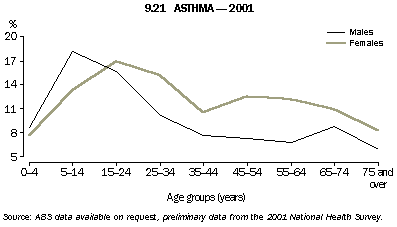The management of asthma is an important public health issue because of the personal burden it places on those with asthma, often with onset in childhood, and the financial burden it places on the health system. In 1996, asthma was estimated to be responsible for 2.6% of the total burden of disease in Australia (AIHW 2000a).
Policy initiatives
A national General Practitioner Asthma Initiative, which focuses on the Asthma 3+ Visit Plan, commenced in 2001 with the Commonwealth Government providing $48.4m over four years to support general practice to better manage the clinical care of people with moderate to severe asthma. General practitioners will receive additional funds through the Practice Incentive Program for each patient with moderate to severe asthma who completes the Asthma 3+ Visit Plan. This plan includes at least three general practitioner consultations (incorporating diagnosis), a written asthma action plan, self-management education and review.
Morbidity
The 2001 NHS estimated that 11.6% of Australians (2.20 million people) currently have long-term asthma (that is, it has lasted or was expected to last for six months or more).
As illustrated in graph 9.21, asthma is particularly prevalent in young people. The International Study of Asthma and Allergy in Childhood reported an estimated prevalence rate of approximately 25% in 6-7 year old Australian children and 29% in 13-14 year olds (ISAAC Steering Committee 1998). In the 2001 NHS, medically diagnosed asthma was more frequently reported by individuals aged less than 25 years than by individuals in older age groups. In this younger age group, asthma was more prevalent in males than females, while for those aged 25 and over the pattern was reversed and asthma was more prevalent in females than males.

 Print Page
Print Page